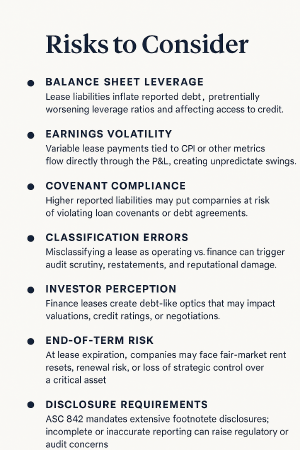Navigating the accounting shift from ownership to lessee
Lease accounting has never been simple, and the adoption of ASC 842 brought it front and center for executives and auditors alike. Nearly all leases now appear on the balance sheet as right-of-use (ROU) assets and lease liabilities, making sale-leasebacks much more transparent—and more complex.
When a company sells property and leases it back, it moves from reporting the property as PP&E (property, plant, and equipment) to being a lessee under ASC 842. This shift doesn’t change the economics of the transaction, but it does change how results are reported, how ratios move, and how investors interpret financial health.
Lease Classification Under ASC 842
ASC 842 requires leases to be classified as either:
- Finance Lease — Recognized with interest expense on the lease liability and amortization expense on the ROU asset.
- Operating Lease — Recognized as a single straight-line lease expense over the term.
The classification is determined by criteria such as whether ownership transfers, whether a bargain purchase option exists, or whether the lease term covers most of the asset’s useful life.
Real-World Example: A Healthcare Provider Sale-Leaseback
A regional healthcare provider owns its headquarters, valued at $20 million. To unlock capital for expansion, it sells the property to an investor and immediately leases it back for 15 years.
- Sale price: $20 million
- Lease term: 15 years
- Present value of lease payments: $15 million
- Classification under ASC 842: Finance Lease (since the lease term covers most of the asset’s useful life).
Journal Entries
Step 1: Record the Sale
Dr. Cash 20,000,000
Cr. Building (PP&E) 20,000,000
(If the book value was less than $20M, a gain would also be recognized. For simplicity, assume book value = $20M, so no gain/loss.)
Step 2: Record Leaseback (Finance Lease Recognition)
Dr. Right-of-Use Asset 15,000,000
Cr. Lease Liability 15,000,000
Step 3: First Lease Payment
Assume annual payments are $1.5 million, with the first payment due immediately. Under ASC 842, the payment is split between interest expense (on the liability) and reduction of principal. Let’s assume the first year’s interest portion is $600,000 and the principal reduction is $900,000.
Dr. Interest Expense 600,000
Dr. Lease Liability 900,000
Cr. Cash 1,500,000
Step 4: Amortize the ROU Asset
For a finance lease, the ROU asset is amortized over the lease term.
Annual amortization = $15,000,000 ÷ 15 years = $1,000,000.
Dr. Amortization Expense 1,000,000
Cr. Accumulated Amortization (ROU Asset) 1,000,000
Why This Matters
- Balance Sheet: $15M lease liability and $15M right-of-use asset.
- Income Statement: Interest expense ($600K) + amortization expense ($1M), instead of smooth rent expense.
- Ratios: Higher leverage due to recognition of lease liability.
- Investor Optics: A debt-like obligation appears, even though economically the company just sold an asset and leased it back.

Risks to Consider
- Balance Sheet Leverage — Lease liabilities inflate reported debt, potentially worsening leverage ratios and affecting access to credit.
- Earnings Volatility — Variable lease payments tied to CPI or other metrics flow directly through the P&L, creating unpredictable swings.
- Covenant Compliance — Higher reported liabilities may put companies at risk of violating loan covenants or debt agreements.
- Classification Errors — Misclassifying a lease as operating vs. finance can trigger audit scrutiny, restatements, and reputational damage.
- Investor Perception — Finance leases create debt-like optics that may impact valuations, credit ratings, or negotiations.
- End-of-Term Risk — At lease expiration, companies may face fair-market rent resets, renewal risk, or loss of strategic control over a critical asset.
- Disclosure Requirements — ASC 842 mandates extensive footnote disclosures; incomplete or inaccurate reporting can raise regulatory or audit concerns.
Final Takeaway
For any company considering a sale-leaseback, ASC 842 changes how the transaction is reported, not the underlying economics. The classification, recognition of liabilities, and ongoing expense presentation all influence how investors, auditors, and lenders view the company.
Proper planning, accurate calculations, and clear communication of risks are essential to ensure compliance and present the transaction in the best possible light.



